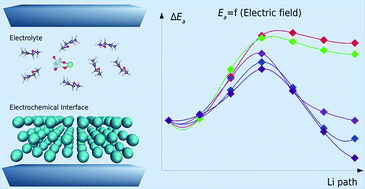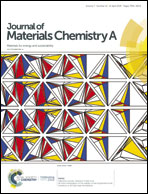Charge-mediated cation deposition on metallic surfaces†
Abstract
This work reveals the general mechanisms of Li+ cation partial reduction and further deposition under specific electrolyte conditions, and in the proximity of an electrified metal surface. The factors affecting the ion complexation and transport and resultant adsorbed structures are identified for various external electric fields and for several applied voltages. Using ab initio methods, we investigate the relation between solvent–salt structures and dynamics, cation reductive stability, and the existing electric field between electrodes, or under the applied potential if the system is designed as an electrochemical cell. In absence of an applied field, it is found that not only cation but also non-solvated salt deposition on a metallic surface is an endothermic process. However, localized surface polarization orbitals created by an external electric field affect both the thermodynamics and kinetics of the adsorption, leading to a drastic change on the energetic profile; ab initio molecular dynamics simulations describe in detail the underlying mechanisms. Externally applied bias to an electrochemical cell also changes the deposition dynamics: by examining various solvent/salt combinations, we unravel the cation deposition mechanisms at both low and moderately high voltages, determining the relative time scale of each separate process. Different polyhedra formed by the metal cation and its surrounding oxygen atoms appear to be the key indicator driving deposition dynamics at different voltages. Our findings disclose the importance of selecting appropriate voltage windows for stable and uniform growth of metal anode layers, showing the mechanisms leading to impurity formation and non-uniform cation deposition, as well as the role of charged interfacial phenomena in designing stable electrode–electrolyte interfaces.



 Please wait while we load your content...
Please wait while we load your content...